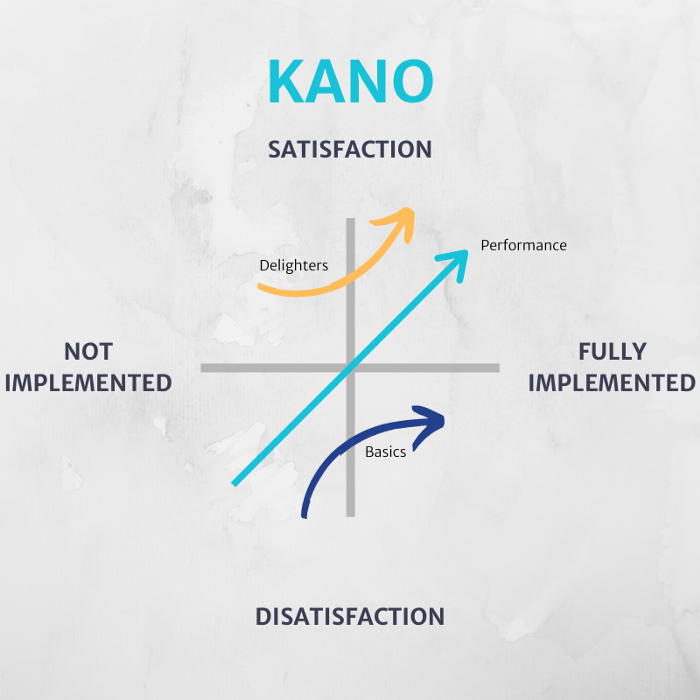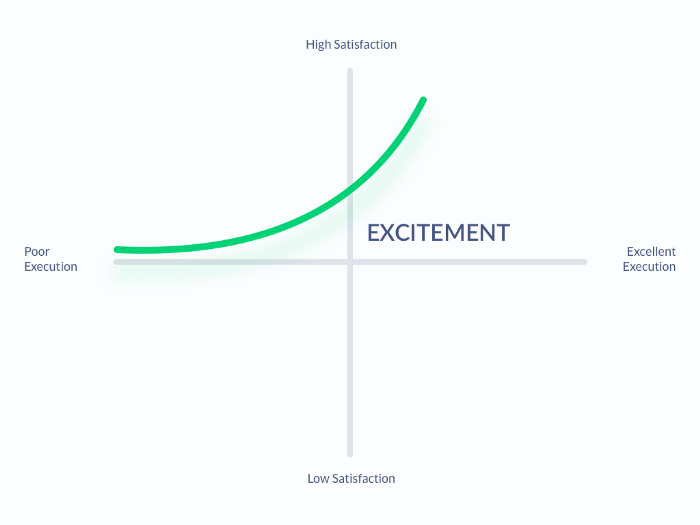1A Satisfied customer is the best source of advertisement. ― G.S. Alag
Delighter is defined by the Merriam Webster Dictionary as something that gives a high degree of gratification or pleasure.
In product terms, delighters are features that make up your brand value proposition and create a competitive advantage. They are features that are not exactly part of the product planning process but added in the long run, mostly after the product has been shipped, solely to increase customer satisfaction and retention.
The concept of delighter was introduced by a Japanese Professor, Noriaki Kano in his popular product strategy framework — The kano model.
The Kano model outlines product attributes based on how customers perceive them — In clearer terms, not all features affect customer satisfaction equally. He uncovered users attitude by using the Kano questionnaire to ask two pairs of important questions, to narrow down feature decision:
- Functional: “How do users feel if they have the feature?”
- Dysfunctional: “How do users feel if they didn’t have the feature?”
In the model, Kano studied customer satisfaction and quality management by mapping out customer satisfaction against effort.

He then identified 4 types of product features and grouped them into:
- Basic features (Threshold):

This category of features is the “Must-have” in a product. Threshold features are either present or not and they have a significant effect on customer satisfaction. Think of an app without a password recovery feature. such brand might not be ready for serious business yet. This set of features is compulsory in any software product. Amongst other examples are responsive web/app design and intuitive user experience.
Neutral features: features that don´t add value and may not be worth developing. A senior PM once said that a stakeholder asked him to integrate games into a banking app to increase satisfaction (yeah, you read that right!). Such feature request shouldn’t be thought of twice. The PM must politely prove to such stakeholder why he thinks the idea is not a good one.
Performance features (Satisfiers):
These features are the ones customers use to make crucial decisions about your product as they have a linear effect on your customer's satisfaction. Their trust in purchasing your service depends on this set of features. They are the major determinant of product success since your customer satisfaction is proportional to them. An example is the page load time of your website or app. Any serious organization would prioritize a fast load time.
Likewise, a secured payment gateway for an e-commerce business will most likely gain the trust of the customer in the brand.
- Delighters (AKA Excitement feature):These are the unanticipated “wow” features that in-turn become one of the drivers of unique selling points. When a delighter is carefully crafted and implemented, they create significant excitement and delight for the users.

It should be noted that delighters are not the essentials of a product — A product can do well without a delighter. Delighter comes in when the PM has noticed some level of dissatisfaction from the users. One relevant way to mitigate this is to introduce an excitement feature which will in-turn curb the discontent.
A very good example of a delighter is the Google Chrome T-rex game which works offline when the user encounter difficulties connecting to the Google server, either as a result of some server error or poor internet connection.
Google has therefore been able to retain an angry and frustrated user who couldn’t access the search engine, by keeping him/her busy playing the game till the connection comes back on. Instead of going to a competitor, The user stays and keeps himself busy while he waits for the internet connection. Before Google could come up with the game, they must have studied their users and noticed a huge churn rate when the connection is bad. Since poor internet connection and server error is inevitable, they had to find a way to contain it, and they did a great job by introducing the game.
As a Product Manager/growth driven startup, you must be able to tell with facts why your product needs a delighter or why it does not need one. Personally, I think any PM that plans on introducing a delighter feature to their product should ask the following questions:
- Will the feature add value to the product and subsequently increase customer satisfaction?
- Is the delighter cost-effective? (Trust me, you don’t want to spend a lot on a feature that is not a must-have).
- Do we really need to add this extra feature? Or will my product do fine without it? (If your users are getting a unique satisfaction from the service delivered by your product, a delighter might just be a liability for you. You don’t need it.)
- Is this the right timing to implement a new feature? Can the roadmap accommodate a new feature at this time? (As agile as a Pm can be, one of his duty is to prioritize decisions).
Beyond these questions, delighters also come with its pros and cons. Once we realize this and allow it guide our planning, it will play a large role in determining if the feature will be successful or not. Proper user study and survey need to be done before proposing an excitment feature. In some cases, users probably just want an intuitive interface or a better user experience other than an entirely different feature. So, PMs should always work hand-in-hand with their users and understand their pain points before coming up with a solution.
However, when properly planned and initiated, delighters tend to increase customer satisfaction and subsequently reduce the churn rate of users in a product.
Conclusively,
Dear PM, startup founder. Before you add that amazing feature to your product, ask yourself the question — Do they need this at the moment? Afterward, find out from your user using the Kano questionnaire (Or whatever works fine with you) as a guideline before making your decision. Also, note that like almost everything, delighters have it’s pros and cons and you will only be able to increase your customer satisfaction and attract only the good part if you understand how your user feel about your product and align your decisions with it.
This article first appeared on my Medium



